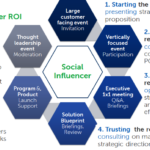It’s no secret that I’m a big proponent of storytelling as a relatively fresh way to approach marketing strategy and execution. Not only did it earn its own chapter in my book The CMO’s Periodic Table, I’ve featured other champions of storytelling like CMO’s Douwe Bergsma (Georgia Pacific) and Darren Marshall (Steinway & Sons) on this blog. In my heart of hearts, I keep hoping that having a story framework rather than a brand-centric messaging framework will reflect and capitalize on the changing dynamic between what a brand wants to say about itself and what a consumer actually says about a brand.
As you might expect, CMOs don’t all share the same perspective on storytelling. Douwe Bergsma sees it as something entirely new and even hired a storytelling agency to craft the story framework for brands like Brawny before getting his other agencies involved. Darren Marshall believes in the importance of telling a compelling story in his communications but didn’t see the need to change his strategic approach. So now, allow me to introduce Maria Winans, CMO of IBM Commerce to this on-going discussion. Maria is a big believer in the power of storytelling and has hired professionals from Hollywood to support these efforts. To understand why, read on.
Drew: As you look to do more storytelling at IBM, has this changed your approach to staffing your marketing team?
Maria: Absolutely. As we look at our staffing needs for today and tomorrow, we are focused on three primary skills sets, digital, portfolio and the ability to engage an audience via storytelling. For the first area, we are hiring the best talent we can find to quickly create new ways of engaging with our audiences in the most personalized ways possible. The second area is more product / category specific in terms of finding talent with deep knowledge of e-commerce and marketing automation. And the third is all about content creation and storytelling in a manner that entertains and informs audiences.
Drew: Interesting. So let’s talk more about the skill sets of the storytellers.
Maria: Sure. These people are not traditional tech-centric IBMers. Their expertise is completely different in that they can create truly engaging content or they know how to lead the creative storytelling process. These folks will help IBM engage specifics audiences in a very different manner than we’ve done before. And working with the rest of our marketing team, the storytellers will help us translate some of our broader themes down to a very compelling and ideally, personalized conversation.
Drew: How else are you bringing the idea of storytelling into IBM?
Maria: One way is by collaborating with organizations like TED. The TED organization is among the best at storytelling and they helped us orchestrate a conversation about innovation last year in a completely new way for us. Presentations were limited to seven minutes, which forced us to make every word count and propel the story forward. We really learned a lot from that.
Drew: So why not outsource your storytelling?
Maria: Frankly, that’s exactly what we did for a long time but it comes at a price. Not the cost of development, but the absence of expertise that comes with knowing how to create stories. Bringing this skill in house uncovering talent and skills in very different places. For example, I’ve recently hired individuals that were doing scriptwriting in Hollywood for film. Their ability to write scripts and plot out storyboards is essential to the kinds of communications we want to create moving forward.
Drew: How does all of the new product or divisional storytelling you’re doing fit into the bigger stories IBM is telling on a corporate advertising level?
Maria: One of the things that we’re looking to do is have content that tracks with the entire customer journey. While the corporate ads are great at positioning all of IBM we need to be more specific with our product and divisional stories, whether we’re talking lead generation or product research or demos. All of this content needs to be compelling enough and personalized enough to drive an action – an action that we can track, score and keep moving forward with other content.
Drew: Let’s dive into this more. Can a big story like Watson get translated into demand generation and lead nurturing for a specific ecommerce product?
Maria: Yes. IBM is telling big stories about the art of the possible by demonstrating Watson’s amazing cognitive learning capabilities. My challenge is to take that big emotion-rich story and appeal to a merchandiser or a supply chain manager with very specific challenges. I need to be able to show them how they can work with IBM in a way that pertains directly to their job and move them along from prospect to customer. It comes down to storytelling on a level that resonates with the target and helping them see cognitive as a competitive advantage for their businesses and an opportunity to excel for them personally.
Drew: How does big data fit into all of this?
Maria: Great question. We marketers have so much data. The key is to be able to use that data to drive personalization and deliver the best possible experience. Obviously, this is easier said than done. It’s important to recognize that data is a means to end and not an end in itself. Data informs the story, how we talk to you, what we share and when we share it. If we know you react to certain words or images, then we’ll be sure to zoom in on those in our stories. Ultimately, our goal is really to make an emotional connection and we think we can do that better by being personal without of course, being creepy.
Drew: So how hard is all of this?
Maria: It’s hard but we’re making a lot of progress. We’re getting better at not forcing a discussion about product too early in the process. Before we introduce a solution, we want to make sure we really understand a particular prospect’s challenge. Some of this we can infer through the data, which makes it a lot easier to start a fruitful conversation. And some of this is understanding narrative, bringing the prospect along through a series of nurturing activities related to their past behavior. Ultimately, this really is another means of being customer centric – we are trying very hard not to waste a prospect’s time by delivering superfluous information.
 When SAP acquired Ariba a few years back, newly appointed CMO
When SAP acquired Ariba a few years back, newly appointed CMO  In the last few years, a number of brands have realized that to earning the trust of consumers isn’t something they’ll be able to accomplish on their own. The reality is that people trust people more than brands, which explains the emergence of influencer marketing. Instead of going straight to their target market, brands are now looking to a chosen few individuals to augment their message and promote their products. Influencer marketing programs have stepped boldly onto the scene and have set up shop in B2C and B2B environments.
In the last few years, a number of brands have realized that to earning the trust of consumers isn’t something they’ll be able to accomplish on their own. The reality is that people trust people more than brands, which explains the emergence of influencer marketing. Instead of going straight to their target market, brands are now looking to a chosen few individuals to augment their message and promote their products. Influencer marketing programs have stepped boldly onto the scene and have set up shop in B2C and B2B environments.